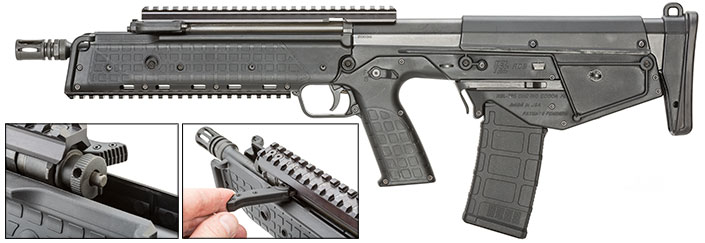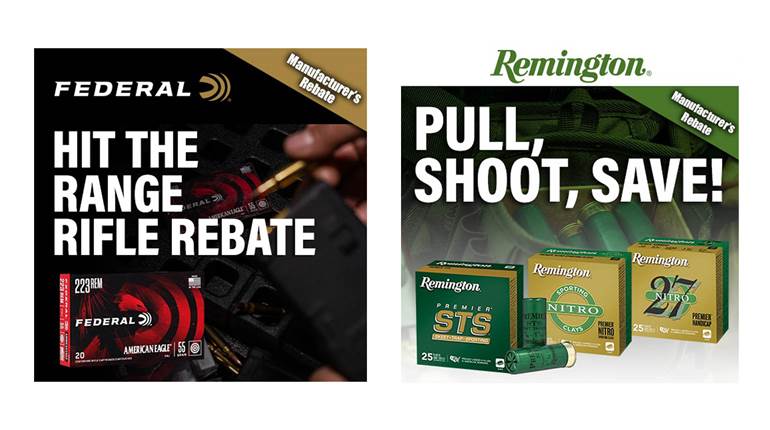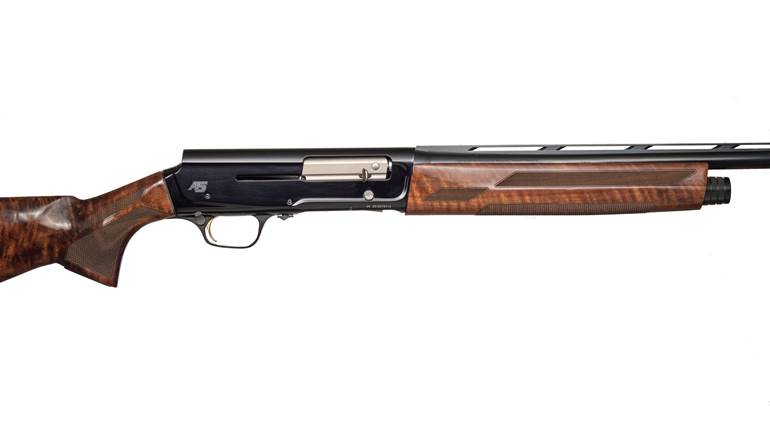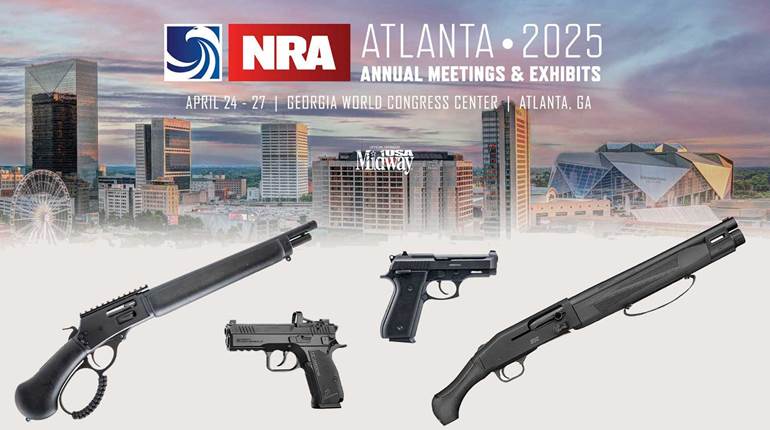
What’s in a name? When it comes to Kel-Tec, the Cocoa, Fla.-based firearm manufacturer, it’s the Swedish heritage of chief engineer and founder George Kellgren combined with the singular characteristic that has driven his designs for the past 25 years: technology.
Sure, Kel-Tec could simply be referred to as a prolific manufacturer of polymer guns, but that would ignore much of its success. And one label that is certainly not appropriate here is “copycat.” No, if Kel-Tec is synonymous with anything, it is the continual release of entirely novel and innovative designs. Such new firearms frequently become fan followings but can be elusive initially because of the company’s limited production capacity.
Given the release of its RDB 5.56x45 mm NATO carbine, which came on the heels of its wildly different KSG bullpup shotgun and forward-ejecting 7.62x51 mm NATO RFB, I think that Kel-Tec is not only onto something, but that the better way to refer to it might be as the King of the Bullpups.
A bullpup action configuration offers the advantage of a standard-length barrel but in a more compact platform. And while Kel-Tec didn’t invent the concept—proven guns such as the British army’s SA80, Steyr’s AUG and lately IWI’s Tavor SAR come to mind—Kel-Tec has done something these others haven’t: Its bullpup rifles are fully bilateral down to their ejection, and they’re also more affordable. How’d they do it? In a word, engineering.
Fact is, the RFB (Rifle, Forward-ejecting Bullpup) is one of the most impressive feats of firearm design since FN’s downward ejecting P90, and that may partially explain why it was announced in 2007 but didn’t begin to ship until 2009. And it really only became available to the masses a few years later.
“The development time on our guns depends on how novel the design is,” said Kel-Tec marketing director Derek Kellgren, son of George Kellgren. “For the RFB in particular, getting the forward ejection to work took trial and error; if there is too much bolt velocity, the firearm will jam, if not enough, the carbine won’t extract properly. It took quite a bit of testing and re-testing to get it to function reliably.”
At first glance the delay seemed costly for Kel-Tec, because consumer anticipation can quickly turn to doubt, while also opening the door for competitors. In the interim, however, IWI’s release of its Tavor to civilians may have actually renewed interest in bullpup designs, as did Kel-Tec’s own KSG. It also allowed Kel-Tec to tweak the RFB before it hit shelves. Then, in early 2015, it doubled down on its bullpup bet by releasing the RDB (Rifle, Downward-ejecting Bullpup).
The RDB builds on the RFB by simplifying its design, improving it, marketing it to the tactical masses by chambering it in .223 Rem. and pricing it competitively with the ubiquitous AR. As such, it’s a fully bilateral tactical carbine that’s at least a foot shorter than the average AR, all for around $1,000. But before we delve into the differences of these two plastic puppies, you should know something about how Kel-Tec came to be.
Nothing If Not Innovative
Kellgren was born in Sweden in 1943. An engineer by trade, he designed guns for Husqvarna and other companies before immigrating to the United States in 1979 where he co-founded Intratec, the maker of the Tec-9. After parting ways with Intratec, in 1991 Kellgren founded Kel-Tec, Inc., and quickly found a niche making easily concealed, inexpensive handguns such as the P-11 that, made with injection-molded polymer, found huge success in America. Flourishing sales allowed Kel-Tec to invest heavily in R&D for new longarm designs. As he’s proven time and again (think PMR-30, SUB-2000 and others), if George Kellgren is going to make something, it’s not likely to be a copy.
Although only 10 percent of all shooters are left-handed, zero percent like hot brass melting their skin. So Kellgren set out to deal with ejection issues that plague bullpup rifle designs, and in doing so had two viable options: forward or down. So what did Kel-Tec do? Both.
Kellgren recognized the advantages of bullpup-style firearms—he’d studied Interdynamic’s MKR bullpup in the 1970s that utilized a “spine” concept where the major components are all attached to the barrel—and noticed a void in the market that probably stemmed from the fact that most bullpup designs were imperfect. It spawned his subsequent SUB-16 bullpup design of the early 1990s and later his SRT-6 and SRT-8 bullpup sniper rifles and, ultimately, the RFB. It’s a gas-piston-operated, semi-automatic rifle chambered in 7.62x51 mm NATO that’s only 27.25" overall, even with its 18" barrel. It’s one of the most compact box-magazine rifles ever chambered in the venerable round. It’s also 100 percent bilateral in control and ejection; it pushes rounds forward out of an innovative ejection chute and onto the ground in front of the shooter’s feet.
Rifle, Forward-Ejecting Bullpup
The secret of the RFB’s forward ejection lies in its tilting bolt and pivoting extractor. Firing from a closed bolt, gas from the cartridge enters the barrel’s oversized port and propels the short-stroke piston rearward an inch, lifting the rear of the square-faced, hollow bolt out of contact with the receiver’s locking shoulder. This enables the entire bolt assembly group, including the reciprocating charging handle, to move rearward, extracting the case. The case is held on both sides of its rim by dual extracting wings that are pinned to the bolt. During the final portion of its 4.4" rearward journey, raceways machined into the receiver cause the bolt’s extractor unit to pivot, still holding the spent case but now angling it 15 degrees upward.

With its twin recoil springs that recede into channels above the receiver now fully compressed, and the hammer cocked by the rearward-traveling bolt carrier, the bolt reverses direction where it strips a fresh round off the magazine by the now-exposed bolt head and pushes it into battery. It simultaneously shoves the still-captured case out the ejection hole located above the chamber. As the bolt reaches the last 1/4" of its travel into battery, raceways cause the extractor to pivot down around the bolt head, capturing the freshly chambered round. When the trigger is pressed again, the entire 1/10th-second cycle starts anew. After the last round from the magazine is extracted from the chamber, the bolt will lock back while still holding it. Therefore the bolt must be released to expel the last case (or live round).
 As brass is pushed out the 12.25"-long aluminum ejection chute it either drops to the ground via gravity if the rifle is held down, or it is pushed into single file up the tube until full, at which time the first round fired is forced out by subsequent rounds. The shooter and his comrades must never worry about hot brass showers.
As brass is pushed out the 12.25"-long aluminum ejection chute it either drops to the ground via gravity if the rifle is held down, or it is pushed into single file up the tube until full, at which time the first round fired is forced out by subsequent rounds. The shooter and his comrades must never worry about hot brass showers.
While the RFB’s pivoting extractor and ejection chute are novel and work great, Kel-Tec itself proved the system may be overkill. While the brass is ejected forward from the receiver, it ultimately lands on the ground at the shooter’s feet—the same place downward-ejected brass lands, but without as many mechanizations.

Rifle, Downward-Ejecting Bullpup
Internally, the 5.56x45 mm NATO RDB’s bolt head looks more like a common AR-15’s bolt; its seven lugs rotate to lock behind corresponding lugs in the chamber and unlock when gas causes its short-stroke piston to shove the recoil spring shroud/bolt actuator rod rearward, rotating the bolt head, flinging it rearward and extracting the cartridge. The secret to the RDB’s downward ejection rests in the location of its extractor and its dual plunger ejectors. The extractor is located on the bottom edge of the bolt head, so that the tendency of the brass when held by its rim’s lowermost edge is to cant downward. And since gravity won’t do it alone, twin plungers apply even pressure on the case head at the 2 o’clock and 10 o’clock positions to ensure the brass (or live round) tilts straight downward forcefully as it is pulled from the chamber.
As the brass is extracted, tension between the case rim and the extractor is maintained as the case scrapes over the top round in the magazine, and the bolt pushes the U-shaped hammer out of the way of the ejection chute while cocking it. When the case reaches the cleared ejection chute, the downward pressure exerted by both gravity and the plungers flips the case downward with enough leverage to free it from the extractor and out the vertical, aluminum-lined ejection port. From there a single, overhead recoil spring, now fully compressed within the bolt assembly, pushes the bolt back into battery, but not before shucking a fresh round from the magazine. It’s ingeniously simple.

Truly Bilateral
Once the ejection issue was solved by two different methods, engineers built the RDB and RFB around those methods, incorporating design variations as necessary, while keeping the guns as similar in look and feel as possible.
Both rifles feature fore-end-mounted charging handles that can be easily moved to the left or right side, although they are slightly different in design. The non-reciprocating handle of the RDB is spring-loaded to fold forward and lock against the fore-end when not in use.
 A 90 degree, lever-type safety is found on both sides of the RFB’s receiver. It allows the thumb to roll it into the forward firing position, while the trigger finger can be used to more efficiently pull it back to safe. The RDB’s is located higher, and is best manipulated with the thumb only. Likewise, dual bolt releases, albeit slightly different on each model, can be quickly manipulated with the thumb of whatever hand is used to change
A 90 degree, lever-type safety is found on both sides of the RFB’s receiver. It allows the thumb to roll it into the forward firing position, while the trigger finger can be used to more efficiently pull it back to safe. The RDB’s is located higher, and is best manipulated with the thumb only. Likewise, dual bolt releases, albeit slightly different on each model, can be quickly manipulated with the thumb of whatever hand is used to change
the magazine.
On the RFB, a single magazine-release lever is cleverly and centrally located behind the magazine well. As such, it can be depressed as the hand naturally places downward pressure on the magazine. After doing so, the thumb slides off the release lever but remains on the magazine.
Conversely, the RDB’s magazine release lever functions in the same way, but is placed on the forward edge of the magazine well so that the index finger depresses it as the magazine is yanked. I found one advantage of this design—at least for small-handed shooters. Rather than gripping the magazine and releasing with the support hand, I can simply flex my grip to release the magazine with the base of my thumb. I suspect, however, that it would be possible for ham-handed shooters to inadvertently release the magazine while shooting, and, in fact, Kel-Tec has updated current models by dipping the release in a plastic coating so it doesn’t scrape shooters’ thumbs.
In sum, the operator’s trigger hand never has to vacate its firing position to work all controls on either of these bullpups. In a few sessions, decent shooters of either dominant hand can master their controls until they’re as fast and intuitive as any rifle available.
External Similarities And Differences
Both the RFB and RDB measure 27¼" from buttpad to flash hider; the RFB is available in barrel lengths of 18" and 24" for an overall length of 27¼" and 33¼", respectively. That’s about a foot shorter than AR-10-style rifles with same-length barrels. The RDB comes with a 17.3" barrel.
Both guns heavily feature Kel-Tec’s square-stippled “Gator Grip” injection-molded polymer. Unlike the firm’s handguns, however, its bullpups contain a healthy portion of steel. Because the bullpup design places the shooter’s face directly over the chamber, Kel-Tec engineers guarded against catastrophic failure by mating the RFB’s plastic fore-end, lower receiver and lower buttstock with a 12¾" long, 1/16" thick piece of 4130 sheet steel that forms the rifle’s cheekpiece and the upper half of the buttstock. For additional protection, it’s reinforced by a 14 1⁄8"-long sheet of steel underneath. Because of the steel on top and the open magazine well underneath, any purge of excessive pressure or flak will be forced down through the magazine well and away from the shooter’s face. The RDB, on the other hand, utilizes a piece of 1/16" polymer for its stock/cheekpeice with a single layer of 1/16" steel for reinforcement underneath.
Both guns can be fieldstripped of their plastic exoskeletons in seconds with bare hands and a bullet, via four assembly pins that are recessed nicely within the lower receiver—the RFB’s pins are captive while the RDB’s are not. This speedy fieldstripping ability is a good thing, but even so, it does little to rectify a common complaint of bullpups, and that is their inability to quickly clear jams without fieldstripping. The tip of a bullet works perfectly to start the pins. After tapping them out, simply hold the rifle by its buttstock—barrel down—then firmly smack the back of the pistol grip to separate the two-piece polymer lower receiver/fore-end from the barrel and action assembly. Pull the charging handle to remove it, then slide the buttstock/cheekpiece off. Next remove the action shroud that contains the bolt and recoil springs from the barrel assembly.
If you wish to separate the RFB’s bolt from its bolt carrier next, simply tap one pin holding it—but doing so is unnecessary for all but the most thorough cleaning because the bolt can be rotated up from its carrier, allowing adequate access. The gas piston can be removed, and even the expansion chamber with the removal of one pin. In less than a minute, each gun can be broken down to easily access its barrel, chamber, bolt, gas piston and trigger mechanism.
The Components
The RFB’s barrel is a medium-contour, 4140 chrome-moly, chrome-lined tube that’s milled to include two 1"-diameter lugs that provide attachment points, as well as two sets of threads for silencers of various design. It features six-groove, 1:11.25" right-hand twist rifling.
At the barrel’s chamber end, the steel receiver is attached to the barrel via a receiver collar and barrel nut that threads onto the barrel. The barrel is again threaded just forward of this collar, where another nut secures one of two machined steel bridge mounts onto an integral barrel lug. This mount, along with the gas block mount, form the attachment points for the fore-end as well as the two arches on which the 9¾" Picatinny rail is mounted. The integral gas block also serves as the chute’s exit hole and tube support.
Just ahead of the gas block is a curious 1/8" diameter threaded section that is apparently intended for a suppressor that would slip all the way over the muzzle and flash hider. Finally, the muzzle terminates in a 5/8-24 threaded barrel portion that accepts the provided lock nut and flash hider or, if you so choose, most .308 Win.-applicable silencers currently available. No doubt, much time and tooling costs are spent on the RFB’s barrel, which is the backbone of the gun.
The RDB’s 1:7" twist barrel design is similar, except of course that it’s smaller at 0.738" in diameter at the barrel collar before tapering to 0.562" near the flash hider.
Both guns’ captive gas systems are adjustable to regulate the amount of gas needed for various loads, suppressor use and environmental conditions. Its gas-restrictor cap is click-adjustable and is prevented from turning inadvertently by use of a detent spring and pin. Kel-Tec recommends optimizing the amount of gas that powers the piston so that it’s just enough to cycle the bolt reliably but not an excessive amount that would subject the gun to undue stress.
To find the optimal position, start by turning the cap 10 clicks from the bottommost, fully tightened position. Then load one round and fire with a now-empty magazine installed. If that fails to lock the action back, apply a clockwise click to the cap and repeat until the action locks back on its own power, then add two more clicks.
To test the rifle with a suppressor, I found that the cap needed to be backed all the way off, then tightened down (clockwise) five turns. In that position, the RFB functioned reliably with a Dead Air Sandman-S suppressor installed.
Another huge plus of both bullpups is their respective use of universally standard magazines. The RFB relies on FAL-type magazines of the metric pattern. As such, one can readily find suitable 5-, 10- and 20-round magazines if the provided polymer 20-rounder (made by Thermold Magazines USA) isn’t sufficient. Seating the magazine in the RFB doesn’t require rocking; rather a straight push does it; likewise, an easy tug straight down while depressing the magazine release lever allows its removal from the well.
The RDB uses AR-style magazines that are as common as tattoos at Sturgis. It ships with one 30-round Gen M3 PMAG, but I tried various metal and plastic mags, and all of them worked.
Notable of both the RFB and RDB’s trigger systems, as any bullpup design mandates, the trigger/hammer linkage spans a long gap created by the magazine well without blocking it. Kellgren accomplished this on the RFB by fabricating a metal trigger-linkage box that outlines the magazine well rather than running down its middle. A bar on its rear runs through the skeletonized hammer that is pinned underneath it to provide a pivot point so it can cock and strike the firing pin. Of course, the hammer is located in the extreme rear of the entire rifle and, as such, requires a special cutout within the buttstock to accommodate its movement. It’s powered by twin springs located ahead of the magazine well that are stretched by the bolt’s rearward travel and locked back as the sear bar is captured by the trigger sear. A roll-type safety rests on the sear bar. The RDB accomplishes the same thing by way of trigger linkage bars that serpentine along each side of the receiver walls before connecting to the mousetrap-esque, U-shaped hammer.
Both the RFB and RDB’s triggers are polymer. Although they’re surprisingly light in pull weight (5 lbs., 7 ozs. and 4 lbs., 9 ozs., respectively), they both contained some creep. While the RFB’s trigger is great for a bullpup that has such long linkages, and certainly much better than typical AKs or FALs—it’s not as light and clean as many ARs. At the time of this writing, Kellgren informed me that the trigger springs have been replaced and the sear surfaces have been smoothed in its latest shipments. He assures me that the triggers now feel better than those of the early units I tested.
To test performance, I mounted a 2-7X 36 mm Zeiss Terra riflescope on the RFB and an EOTech red-dot sight and 4X coupler on the RDB. I fired 300 rounds through each gun, during which time I noted many failures to feed when switching between brands of ammunition; but each time, after adjusting the gas regulator, all cartridges fired and cycled properly. Only twice each did the rifles jam due to a non-gas-related error, such as a double feed.

Neither gun was a tack-driver—nor were they expected to be—and both guns’ groups spread as their barrels heated during rapid fire. I averaged 2.54" groups at 100 yds. with the 7.62 mm, and 2.88" groups with the 5.56 mm using three types of ammunition for each rifle. Recoil, even in the 7.62 mm RFB, was mild thanks to a long bolt travel and the rifle’s 8-lb., 8-oz.-loaded heft, but muzzle flip due to the weight-back design was significant while shooting from a benchrest where the support hand does not work to anchor the barrel. When shooting from the bench, I drew two solid conclusions: 1.) The RDB’s downward ejection is not ideal for benchrest and prone work because it makes the use of a rear bag difficult, and hot brass can pile around the rear elbow. 2.) The .308 Win. RFB needs a softer cheekpiece.
I quickly familiarized myself with both guns’ controls, and grew fond of the RDB’s magazine release location. The guns’ polymer exoskeleton stocks incorporate many features molded directly into them such as attachment points for bilateral slings. The RDB features a full-length rail molded to the underside of the fore-grip—seemingly a no-brainer—that’s perfect for a flashlight or a vertical fore-end. The RFB’s fore-end is flared, Schnabel-like and discourages fingers from contacting a hot barrel. This is a very compact gun and so reaching far out on the fore-end is natural.

While there are many opinions levied on “balance,” I offer that on rifles of this sort, balance matters very little. The RDB and RDF bullpups are balanced in the literal sense. Their balance points reside on the pistol grip, or the center of the gun. This results in a rifle that feels different than most whose balance point is somewhere along the fore-end. After getting accustomed to this weight-back feel, there are some advantages. Namely, because less weight is on the front end, these bullpups are easy to hold, aim and fire with one hand—something I can’t easily do with a typical AR-10, especially during extended range use. Certainly the overall shorter length is a huge benefit both in compactness and in carrying while slung on the chest because the barrel does not extend past the knees.
While I was somewhat skeptical of these radical designs from Kel-Tec, I now adore both guns, and I appreciate this innovative maker of affordable firearms more than I previously did. After all, I’m a giant fan of any 20-round, .308 rifle that can be kept fully assembled in a tennis racket case. Before shooting extensively, I thought I’d like the simpler RDB better—that only uses one rearward motion of the bolt to eject the round downward—but frankly there’s no downside to the RFB’s forward ejection. It’s nifty. Both guns are extremely solid in design and function.
Kel-Tec’s bullpups are practical and compact rifles that shoot equally great from either side. Whether the company makes enough of them to satisfy demand remains to be seen. Regardless, I give Kellgren and Kel-Tec props for doing something different, and doing it well. But I want to know, does the company intend to release more, er, hounds in the future?
“Oh yes,” Derek said, emphatically.






































